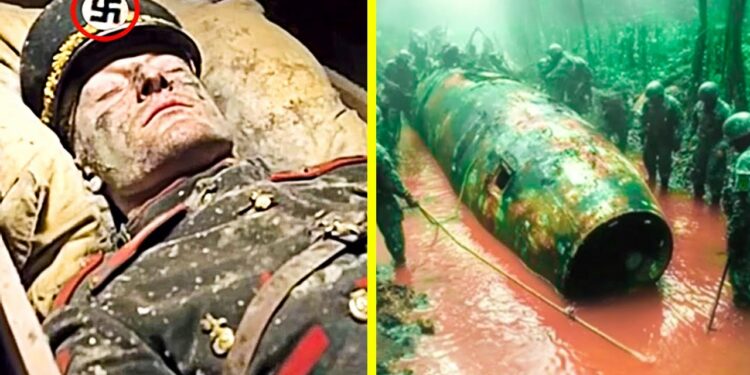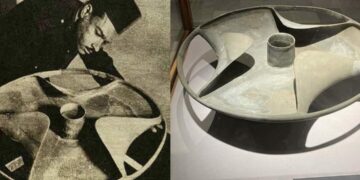World War II, the most devastating conflict in history, left behind a trove of secrets and treasures frozen in time. From hidden bunkers to groundbreaking inventions, these discoveries, concealed for over eight decades, offer a fresh perspective on the war. Here are the most intriguing finds from World War II.
50. Sergeant Dennis Copping and His Kittyhawk P-40 Plane
In May 2012, a Polish oil worker discovered a remarkably preserved P-40 Kittyhawk plane in Al Wadi Al Jadida, a remote Egyptian desert 200 miles from the nearest town. Flown by 24-year-old RAF pilot Sergeant Dennis Copping on June 28, 1942, the plane crash-landed after getting lost during a repair flight between British airfields. A parachute used as a shelter was found nearby. The Egyptian military secured the plane’s weapons, and human remains were found but not identified as Copping’s, leaving his fate unresolved. Dubbed the “aviation equivalent of Tutankhamun’s tomb,” the plane’s near-perfect condition astonished historians.
49. The Allies’ Ghost Army
The U.S. Army’s “Ghost Army,” a unit of 1,100 artists, designers, and sound engineers, used deception to mislead Nazi forces. The 23rd Headquarters Special Troops and 3133rd Signal Company Special employed inflatable tanks, fake radio transmissions, and sound effects to simulate large Allied forces near enemy lines. Their efforts saved thousands of lives during operations like D-Day and the Battle of the Bulge, often operating just yards from the front.
48. Marge (P-38 Lightning)
In Papua New Guinea, researchers recently uncovered the wreckage of “Marge,” a Lockheed P-38 Lightning flown by ace pilot Richard Bong, who downed 40 enemy planes. Piloted by Thomas Malone in 1944, the plane crashed due to mechanical failure. Located in a jungle ravine with help from locals and the Richard I. Bong Veterans Historical Center, Marge was identified by its red paint and serial number.
47. Admiral Graf Spee
The German pocket battleship Admiral Graf Spee, commanded by Captain Hans Langsdorf, sank nine Allied vessels (over 50,000 tons) in the South Atlantic and Indian Oceans. During the 1939 Battle of the River Plate, it damaged HMS Exeter but was outgunned by three British cruisers. Tricked by British misinformation, Langsdorf scuttled the ship in Montevideo. Rediscovered in 2006 by Alfredo Etchegaray, its artifacts, including a gun turret, are displayed at Montevideo’s National Marine Museum.
46. The Enigma Machine
The German Enigma machine encrypted communications with trillions of possible combinations. Allied cryptographers, led by Alan Turing at Bletchley Park, cracked it, decoding 10% of German messages by war’s end using early computers. The Germans’ addition of two rotors (from three to five) required constant Allied efforts to capture updated machines and codebooks.
45. Dornier Do 17
In 2013, a Dornier Do 17 bomber, shot down during the 1940 Battle of Britain, was recovered from the Goodwin Sands off Kent, England. Discovered by fisherman Bob Peacock and surveyed by Wessex Archaeology, the “Flying Pencil” was raised by the RAF Museum. It now resides at RAF Cosford, where conservation continues.
44. Sikorsky Helicopter
In 1939, Igor Sikorsky’s VS-300, the first practical helicopter, introduced the single main rotor and tail rotor design. Logging over 102 flight hours, it was donated to the Edison Museum in 1943. The VS-316, its mass-produced successor, marked the start of modern helicopter use in WWII.
43. The Manhattan Project
The Trinity Test on July 16, 1945, in New Mexico detonated “Gadget,” the first atomic bomb, equivalent to 21,000 tons of TNT. Part of the Manhattan Project, it confirmed nuclear weapon designs, leading to the bombings of Hiroshima and Nagasaki, ending the war.
42. Carrier Pigeon
In 2012, a carrier pigeon’s remains were found in a Surrey, England, chimney with a coded message from WWII, possibly from D-Day, intended for Bletchley Park. Signed by Sergeant W. Stott, the message remains partially undeciphered due to the pigeon’s likely disorientation.
41. Soviet Military Motorcycle
A WWII Soviet motorcycle, used for logistics, was found buried near Vyborg, Russia. Likely hidden to avoid capture, it was uncovered during a relic-hunting mission, shedding light on Soviet wartime operations.
40. Heinkel He 178
On August 27, 1939, the Heinkel He 178, the world’s first jet-powered plane, flew with a top speed of 380 mph. Designed by Ernst Heinkel and Hans von Ohain, it pioneered jet propulsion despite its fixed landing gear.
39. Panther Tank
In 2015, German authorities found a Panther tank, anti-aircraft cannon, and Nazi memorabilia in an 84-year-old man’s Heikendorf home. Used as a snowplow in 1978, the tank led to a conviction for illegal weapons possession, with a fine and order to donate it to a museum.
38. WWII Bomb
In 2017, a massive WWII bomb was found at a London construction site. British Army experts safely defused and removed the 70-year-old explosive, which posed a significant risk.
37. Chariot
The British “Chariot,” a manned torpedo inspired by Italian designs, was developed in 1942. The Mark I and II models, built by Stothert & Pitt, carried explosives to sink enemy ships. Used in Sicily’s invasion, they achieved mixed success.
36. Anne Frank’s Diary
Anne Frank received her diary on June 12, 1942, documenting her family’s hiding during the Nazi occupation. Found by Miep Gies and Bep Voskuijl after their arrest, it was preserved by Otto Frank. Anne died in Bergen-Belsen in 1945, weeks before liberation.
35. USS Samuel B. Roberts
In June 2022, the USS Samuel B. Roberts (“Sammy B”), sunk in the 1944 Battle of Samar, was found at 22,621 feet in the Philippine Sea, the deepest shipwreck ever located. It fought bravely against Japanese forces during the Leyte Gulf invasion.
34. V-2 Rocket
In 2023, archaeologists in southeast England excavated a V-2 rocket crater from February 1945. Over 1,700 pounds of debris, including the combustion chamber, were recovered from farmland, revealing the rocket’s supersonic impact.
33. Father of Radar
Robert Watson-Watt’s 1930s radar technology, using radio waves to detect enemy planes, was pivotal in the 1940 Battle of Britain, providing early warnings against Luftwaffe attacks.
32. Heaven Can Wait
The B-24 Liberator Heaven Can Wait vanished in 1944 near Papua New Guinea. Found in 2017 by Project Recover using sonar, its 2018 confirmation and 2023 recovery honored its 11 lost crew members.
31. Soviet T-34 Tank
A T-34 tank, lost in the Donets River, Russia, was recovered in 2023. Likely submerged during a bridgecrossing, it was found intact with ammunition and crew items. Restoration is underway at Patriot Park, Moscow.
30. Führerbunker
In 1945, photographer William Vandivert documented Hitler’s Berlin bunker, capturing a bloodstained sofa linked to Hitler and Eva Braun’s final moments. Empty fuel cans outside suggested their bodies were burned to evade Allied capture.
29. Reconnaissance Pigeons
In 1907, German apothecary Julius Neubronner used pigeons with timed cameras for aerial surveillance. Refined by the Swiss in the 1930s and used in WWII, the CIA later developed battery-powered versions.
28. Bismarck
The German battleship Bismarck, launched in 1939, sank the HMS Hood in 1941 but was destroyed by the Royal Navy. Found in 1989 at 4,790 meters in the Atlantic, it remains a symbol of naval power.
27. Nazi Stash
In 2021, history teacher Sebastian Yurt found Nazi artifacts, including a Hitler portrait and gas masks, hidden behind a wall in Hagen, Germany. The building once housed a Nazi welfare office.
26. Paratrooper Bikes
The BSA airborne bicycle, used by British paratroopers in D-Day and Arnhem, allowed silent mobility. Over 60,000 folding bikes were produced, now rare museum pieces.
25. Bantam Jeep
The 1941 Bantam Jeep, a light 4×4 vehicle, met U.S. Army mobility needs. Post-war, Bantam shifted to trailers and was acquired by American Rolling Mills in 1956.
24. Underwater B-17 Flying Fortress
Shot down in 1944, a B-17 sank near Vis, Croatia, after engine failure. Discovered in 2001 at 70 meters, the well-preserved wreck holds the co-pilot’s remains.
23. Cars Cemetery
In France, rusted cars hidden during WWII to avoid military requisition were found in a quarry pit. Most were too damaged to move, but some were auctioned.
22. DUKW Amphibious Vehicle
The DUKW, a 2.5-ton amphibious truck, transported supplies during the 1943 Sicily and 1944 Normandy invasions. Post-war, surplus DUKWs were repurposed for tourism.
21. Tallboy Bomb
In 2020, a 5.4-ton Tallboy bomb detonated during defusing in a Baltic Sea canal near Świnoujście, Poland. Dropped by the RAF in 1945, it targeted the German cruiser Lützow.
20. Churchill’s Secret Army Bunker
A WWII bunker used by Churchill’s auxiliary units was found in Scotland’s Craigielands Forest. Hidden for secrecy, it housed seven men with weapons for sabotage.
19. War Loot
In 2015, a British team recovered £50 million in silver rupees from the SS City of Cairo, sunk in 1942 at 5,150 meters in the Atlantic, the deepest salvage operation ever.
18. Nazi Panzer Tank
In 2023, a Panzer tank was found in Poland’s Drawa River, lost in 1945 during a German retreat. Local legends guided its discovery.
17. HMS Thistle
Norwegian researchers found the British submarine HMS Thistle, sunk in 1940 by a German U-boat, at 500 feet off Rogaland, Norway.
16. War Artifacts in Cans
In 2017, 14-year-old Patrick Lesman found WWII artifacts, including a Wehrmacht uniform, in milk cans near Lake Jeziorak, Poland. They belonged to the von Finckenstein family.
15. Joseph Goebbels’ Bunker
In 1998, a Holocaust Memorial construction in Berlin uncovered a chamber linked to a significant WWII figure, sealed since the city’s bombings.
14. USS Indianapolis
Sunk in 1945 after delivering atomic bomb components, the USS Indianapolis was found in 2017 at 5,500 meters in the Philippine Sea, marking the U.S. Navy’s worst disaster.
13. Colossus II
Developed in 1943 at Bletchley Park, the Colossus II, an early electronic computer, decrypted German Lorenz codes. Its existence was secret until the 1970s.
12. Graf Zeppelin
The Graf Zeppelin (LZ-127), a 236.5-meter airship, used hydrogen and five Maybach engines for a top speed of 128 km/h. Its aluminum-coated frame minimized solar heating.
11. Japanese I-400 Class Submarines
These 400-foot submarines, the largest of WWII, carried three Aichi M6A seaplanes in watertight hangars, launching them via catapult for attacks.
10. Musashi
The Japanese battleship Musashi, sunk in 1944 during the Battle of Leyte Gulf, was found in 2015 at 3,280 feet in the Sibuyan Sea by Paul Allen’s team.
9. British Hurricane Fighter Planes
Eight Hurricane fighters, sent to the Soviet Union in 1941, were found buried near Kyiv, Ukraine, hidden to avoid lend-lease repayment.
8. Banned Treasure Map
In 1944, four German soldiers robbed a bank in Arnhem, Netherlands, hiding loot worth millions. A 1945 map, released in 2023, points to a lost poplar tree in Ommeren, but treasure hunts are banned due to explosives risks.
7. Hidden Village
St. Erth, Cornwall, secretly housed an MI6 outstation during WWII, monitoring German U-boat communications. Its codebook, left by operator Harry Griffiths, revealed its role in aiding Bletchley Park.
6. YIVO Library
In Vilnius, Lithuania, Jewish scholars hid 70% of the YIVO Institute’s library during Nazi occupation. Discovered in 1989 and 2016, these 420,000 pages are among the most significant Jewish archives since the Dead Sea Scrolls.
5. Japanese Artifacts
In 2023, a Massachusetts family found 22 looted Japanese artifacts from Okinawa in their father’s attic, including 18th–19th-century scrolls and ceramics, returned to Japan.
4. Nazi Nuclear Weapon Complex
A WWII aircraft factory tunnel in Austria, with unusual radiation levels, is under investigation. Concrete-filled for safety, it’s now being excavated to uncover its secrets.
3. Unit 731
Chinese archaeologists found a 108×67-foot bunker near Anda, believed to be Japan’s Unit 731, which conducted horrific experiments on 12,000 victims during WWII.
2. Mikasza Diary
A diary by an SS officer, “Mikasza,” details Nazi plans to hide looted wealth. Donated in 2019 by a Quedlinburg lodge, it lists 11 sites, including 30 tons of gold possibly under Hochberg Palace, Poland.
1. Message for Irish Pilots
In 1944, Ireland marked “Éire” in stones along its coast to signal neutrality to pilots. A previously unknown sign with the number 8 was revealed in 2018 near Bray after wildfires.
These discoveries illuminate the ingenuity, bravery, and tragedies of WWII, reshaping our understanding of this pivotal era.























